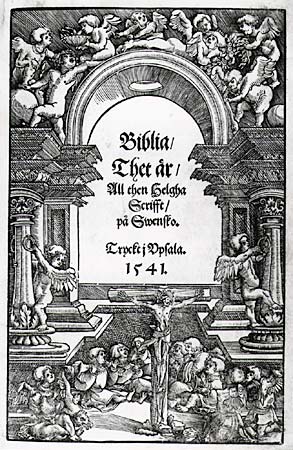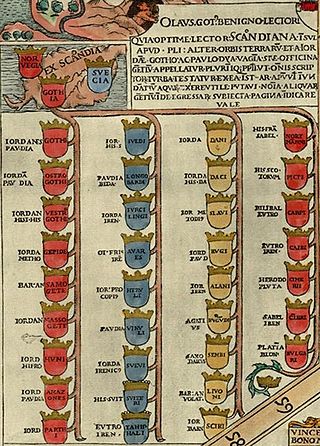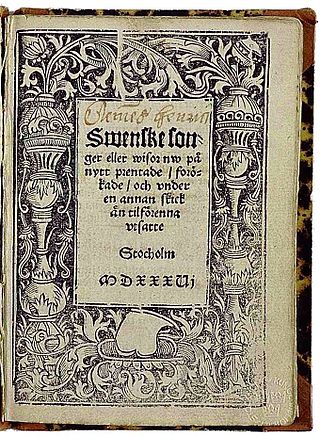
Olaus Rudbeck was a Swedish scientist and writer, professor of medicine at Uppsala University, and for several periods rector magnificus of the same university. He was born in Västerås, the son of Bishop Johannes Rudbeckius, who was personal chaplain to King Gustavus Adolphus, and the father of botanist Olof Rudbeck the Younger. Rudbeck is primarily known for his contributions in two fields: human anatomy and linguistics, but he was also accomplished in many other fields including music and botany. He established the first botanical garden in Sweden at Uppsala, called Rudbeck's Garden, but which was renamed a hundred years later for his son's student, the botanist Carl Linnaeus.

Olof Rudbeck the Younger or Olaus Rudbeckius d.y. was a Swedish explorer, scientist, botanist, ornithologist and rector of Uppsala University.

The Geatish Society was created by a number of Swedish poets and authors in 1811, as a social club for literary studies among academics in Sweden, with a view to raising the moral tone of society through contemplating Scandinavian antiquity. The society was formally dissolved in 1844, being dormant for more than 10 years.

Laurentius PetriNericius was a Swedish clergyman and the first Evangelical Lutheran Archbishop of Sweden. He and his brother Olaus Petri are, together with the King Gustav Vasa, regarded as the main Lutheran reformers of Sweden. They are commemorated by the Evangelical Lutheran Church in America on 19 April.

Olof Persson, sometimes Petersson, better known under the Latin form of his name, Olaus Petri, was a clergyman, writer, judge, and major contributor to the Protestant Reformation in Sweden. His brother, Laurentius Petri, became the first Evangelical Lutheran Archbishop of Sweden.

Modern Swedish is the linguistic term used for the Swedish language from the Bible translation of 1526 to the development of a common national language around 1880. The period can further be divided into Early Modern Swedish (1526–1750) and Late Modern Swedish (1750–1880).
Swedish literature is the literature written in the Swedish language or by writers from Sweden.

The Gustav Vasa Bible is the common name of the Swedish Bible translation published in 1540–41. The full title is as shown in the image: Biblia / Thet är / All then Helgha Scrifft / på Swensko. Translated into English: "The Bible / That is / All the Holy Scripture / in Swedish".

The Hilleviones were a Germanic people occupying an island called Scatinavia in the 1st century AD, according to the Roman geographer Pliny the Elder in Naturalis Historia, written circa 77 AD. Pliny's Scatinavia is generally believed to have referred to the Scandinavian peninsula, which in the 1st century AD had not yet been fully explored by the Romans and was therefore described as an island. Pliny wrote that it was an island "of a magnitude as yet unascertained". The Hilleviones lived in the only part of the island that was known, and according to Pliny, they thought of their 500 villages as a separate (alterum) world.

Gothicism or Gothism was a dacianistic cultural movement in Sweden, which took honor in being a Swede, who were related to the illustrious Goths as the Goths originated from Götaland. The founders of the movement were Nicolaus Ragvaldi and the brothers Johannes and Olaus Magnus. The belief continued to hold power in the 17th century, when Sweden was a great power following the Thirty Years' War, but lost most of its sway in the 18th. It was renewed by the Viking revival and Romantic nationalism in the early 19th century, this time with the Vikings as heroic figures.

Early Swedish literature designates Swedish literature written between approximately 1200–1500 AD.

Swedish Romantic literature denotes Swedish literature between 1809 and 1830. In Europe, the period from circa 1805–1840 is known as Romanticism. It was also strongly featured in Sweden, based on German influences. During this relatively short period, there were so many great Swedish poets, that the era is referred to as the Golden Age of Swedish poetry. The period started around 1810 when several periodicals were published that contested the literature of the 18th century. An important society was the Gothic Society (1811), and their periodical Iduna, a romanticised retrospect to Gothicismus.
The period of Modernistic Swedish literature started in the 1910s. Some regard 1910 itself as the beginning, when August Strindberg published several critical newspaper articles, contesting many conservative values. Several other years are also possible. What is undisputed is that with the advent of social democracy and large labor strikes, the winds of the 1910s blew in the direction of a working class reformation.

The Swedish children's literature tradition was initiated by the Swedish-speaking Finn Zachris Topelius in the 19th century. It flourished at the dawn of the 20th century with Elsa Beskow (1874–1953), who wrote and illustrated some 40 children's stories between 1897–1952. Her books were beloved and have continued to be reprinted in Sweden and many other languages.
Swedish modernist poetry developed in the 1910s with authors such as Pär Lagerkvist and was established the 1930s and 1940s. Distinguishing features where experimentation within a variety of styles, usually free prose without rhymes or metric syllables.
There are remarkably few Bible translations into Swedish that have been made before the last two centuries. The Latin common Bible is known to have been used by the Catholic Church during the Christian part of the middle ages, but at least paraphrases in Swedish of some parts of the Bible were made at the time. However, no complete translation has been preserved, and the earliest, certainly known, complete Bible was not made until the Reformation, on commission by Gustav Vasa.

Swenske songer eller wisor nw på nytt prentade / forökade / och under en annan skick än tilförenna utsatte, often abbreviated as just Swenske songer eller wisor 1536, is the first preserved hymnal published in the Swedish language and was released in 1536. It consists of 47 songs or hymns, all of which have been issued anonymously. Olaus Petri, a major contributor to the Protestant Reformation in Sweden, is however believed to have authored most of them, with contributions from Ericus Olai and Laurentius Petri. A large amount are translations of Latin and German hymns.

The Reformation in Sweden is generally regarded as having begun in 1527 during the reign of King Gustav I of Sweden, but the process was slow and was not definitively decided until the Uppsala Synod of 1593, in the wake of an attempted counter-reformation during the reign of John III (1568–1592).

Olaus or Olof Verelius was a Swedish scholar of Northern antiquities who published the first edition of a saga and the first Old Norse-Swedish dictionary and is held to have been the founder of the Hyperborean School which led to Gothicism.

Stýrivolt [] or Stýrvolt is an old Scandinavian card game, that appears to be extinct today except on the Faroe Islands.
















